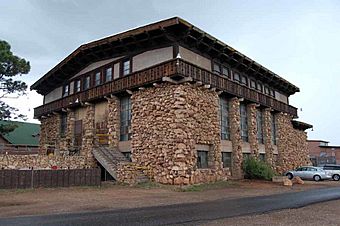Grand Canyon Power House facts for kids
|
Grand Canyon Power House
|
|
|
U.S. National Historic Landmark District
Contributing Property |
|
 |
|
| Location | Grand Canyon National Park, Arizona |
|---|---|
| Built | 1926 |
| Architect | Atchison, Topeka & Santa Fe RR |
| Part of | Grand Canyon Village Historic District (ID75000343) |
| NRHP reference No. | 87001411 |
Quick facts for kids Significant dates |
|
| Added to NRHP | May 28, 1987 |
| Designated NHL | May 28, 1987 |
| Designated NHLDCP | February 18, 1987 |
The Grand Canyon Power House is an old building that used to make electricity for the Grand Canyon National Park. It powered buildings and services at the South Rim. This power house is special because of its unique design. It looks like a rustic mountain lodge, even though it was an industrial building!
It has been named a National Historic Landmark. This means it's a very important place in American history because of its design and how well its old equipment has been kept.
Contents
Building the Power House
The Grand Canyon Power House was built in 1926. The Atchison, Topeka and Santa Fe Railway constructed it. They needed electricity for their buildings at the South Rim. These included the train station, the El Tovar Hotel, and the Bright Angel Lodge. The power house also made steam to heat train cars.
No one knows for sure who designed the building. It's thought to be an architect who worked for the Santa Fe Railway. The power house replaced an older building that had boilers and pumps.
From Railroad to Park Service
The railway ran the power house until 1954. Then, the National Park Service bought it. They hired the Fred Harvey Company to operate it. This company was the main business that provided services in the park.
The power house stopped making electricity in 1956. Its tall smokestack was taken down right away. Today, the building still has its original diesel generators, pumps, boilers, and electrical gear. The Fred Harvey Company now uses the building for storage.
What the Power House Looks Like
The Grand Canyon Power House is a strong building made with a concrete frame. But it's covered in a rustic style that makes it look like a huge Swiss chalet. Even though it's a big building, its design makes it seem smaller. It also helps it blend in with the beautiful natural landscape.
The design uses ideas from the nearby El Tovar Hotel, which also has a Swiss-rustic look. The building's details are made to create a "trompe-l'œil" effect. This means things like the balcony rail and windows look much bigger than they normally would. This trick makes the building seem even more grand.
Blending with Nature
The building is built right into a slope. This helps to make it look less bulky. The main part of the building has a tall floor above a lower basement. All of this is covered in rough limestone. The stone has a textured look with deep lines between the pieces.
Above the stone, there's an upper story made of painted concrete. It has a false balcony with a high railing on three sides. The windows on the upper story are made of steel and have wooden frames. The roof is gently sloped with wide, heavy eaves. A section on the west side was added later. It was built to hold a refrigeration plant. You can still see some of its cork insulation inside.
Inside the Power House
The inside of the building is divided down the middle. It follows the line of the roof. There's a wall made of industrial steel and glass. Steel beams hold up the roof, which is made of wood. The original Fairebanks-Morse diesel generators are still there. They are surrounded by walkways. A special crane used to move the generators is also still intact.
A new structure has been built inside the power house. It has many levels and is used for storage and offices. This new structure is separate from the original building. It can be removed without causing any harm to the historic power house.
Important Designations
The Grand Canyon Power House was named a National Historic Landmark on May 28, 1987. This means it's recognized as a place of great national importance. It is also part of the Grand Canyon Village National Historic Landmark District.
- Historic American Engineering Record (HAER) No. AZ-2, "Grand Canyon Power Plant, Coconino, Coconino County, AZ", 13 photos, 1 photo caption page



